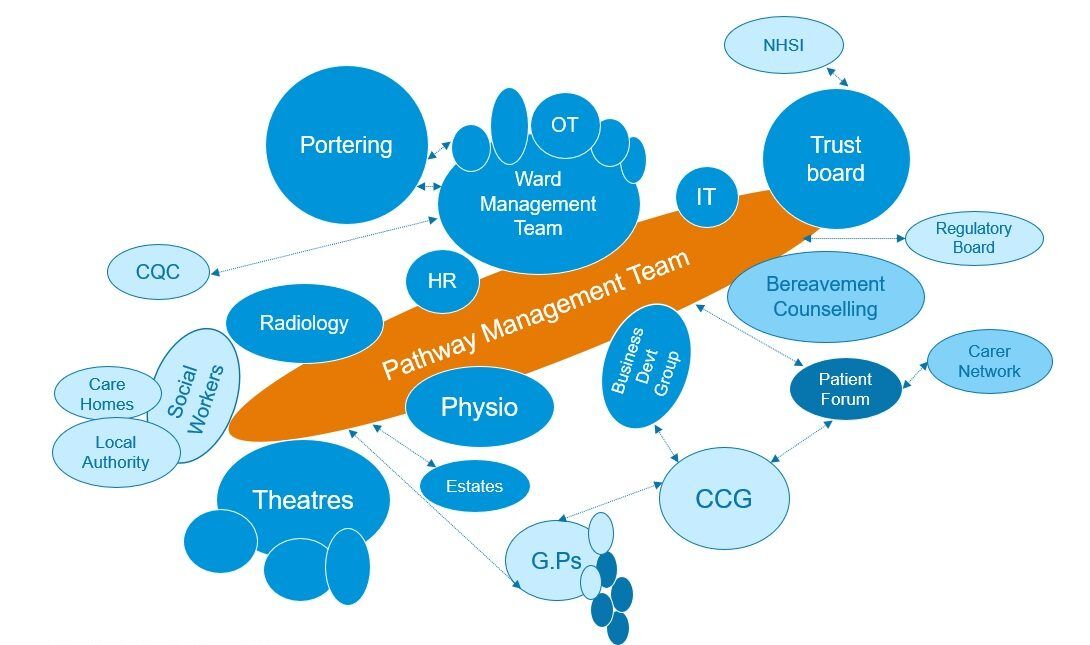What role does team based working play in collective leadership?
by Sarah-Jane Dale and Michael West
Organisations in health and social care need to stop working in silos and begin to work better across professional groups, across specialisms and across organisational boundaries to create truly integrated care. This is horizontal working.

Collective Leadership is fundamental to the achievement of effective integrated working and to services which are organised around the needs of the patient or service user, rather than the needs of the organisation or individual staff member.
The Collective Leadership concept provides a framework for thinking about the leadership required to create organisational cultures which enable truly integrated care to become a reality rather than remain an elusive dream.
From committees to teams
The prevalence of ‘committee working’ rather than ‘team working’ is one of the great problems encountered in many organisations.
Too often individuals come to multi-disciplinary ‘team’ meetings with the aims of representing their specific professional or organisational interests. This often results in competition for resources and decision making power rather than a positive focus on the outcomes required of the team.
If we are to develop Collective Leadership in health and social care organisations we must move from committee working to effective team working. Effective team working enables individuals with different knowledge, skills and experience to work together synergistically to create innovative solutions to problems and bring about improved outcomes. This is horizontal working in practice.
Many of the evidence-based practical tools we use to change attitudes and support more effective team based working cultures are also critical to the development of effective collective leadership.
Take a look at the following examples.
The team community map concept
Everyone working in health and social care is busy – busy doing what is immediately urgent and important. This often means that there is little time to look up and around to see how our work impacts on others.
In complex environments no one team can deliver the outcomes required by patients, service users or the organisation. We need to be encouraging all staff at all levels to be thinking ‘communities of teams’ rather than ‘individual teams’. Again, this is the practice of horizontal working at the heart of integrated care.
We use the concept of team community maps to bring to the attention of all staff the complexity of relationships which need to be managed and maintained if the team is to be successful.

These community maps have become more complex over the years. Most maps now reach far beyond the organisation’s boundaries to partner providers in the public, private and third sectors, to regulators, to patient groups and more – horizontal working
Leaders of teams in complex environments need to be ‘leading upward and outward rather than inward and downward’. They also need to be helping all staff to understand the complex terrain in which they work.
The home team concept
Most staff in health and social care organisations already work in more than one team, some of them reporting membership of as many as 10 teams! On the one hand this helps to build awareness of the needs of disparate areas of the organisation, on the other it increases levels of individual stress and can prevent effective decision making.
Key to the effectiveness of multi-team membership is the concept of the home team. Our definition of home team is ‘the team whose objectives determine how you work in all the other teams of which you are a member’. Usually, but not always, this is the most senior team to which the individual belongs.
This concept creates the alignment which is so important to the delivery of effective organisational outcomes. Hopefully it mitigates the danger that Collective Leadership drifts towards consensus leadership with too little direction.
The home team concept is key to solving the problem of ‘committee working’ rather than ‘team working’ in many organisations.
Team-based working
Team-based working (TBW) is about creating organisational cultures which enable decision making by teams, rather than by individuals, and at the closest possible point to the patient or service user.
The prinicples of TBW are fundamental to the creation of cultures of collective leadership.
Watch our video Michael West: Why Teams? Creating Collective Leadership for more details about building a team based working culture which enables Collective Leadership.
Sign up to our newsletter to receive great articles like this straight to your inbox.



